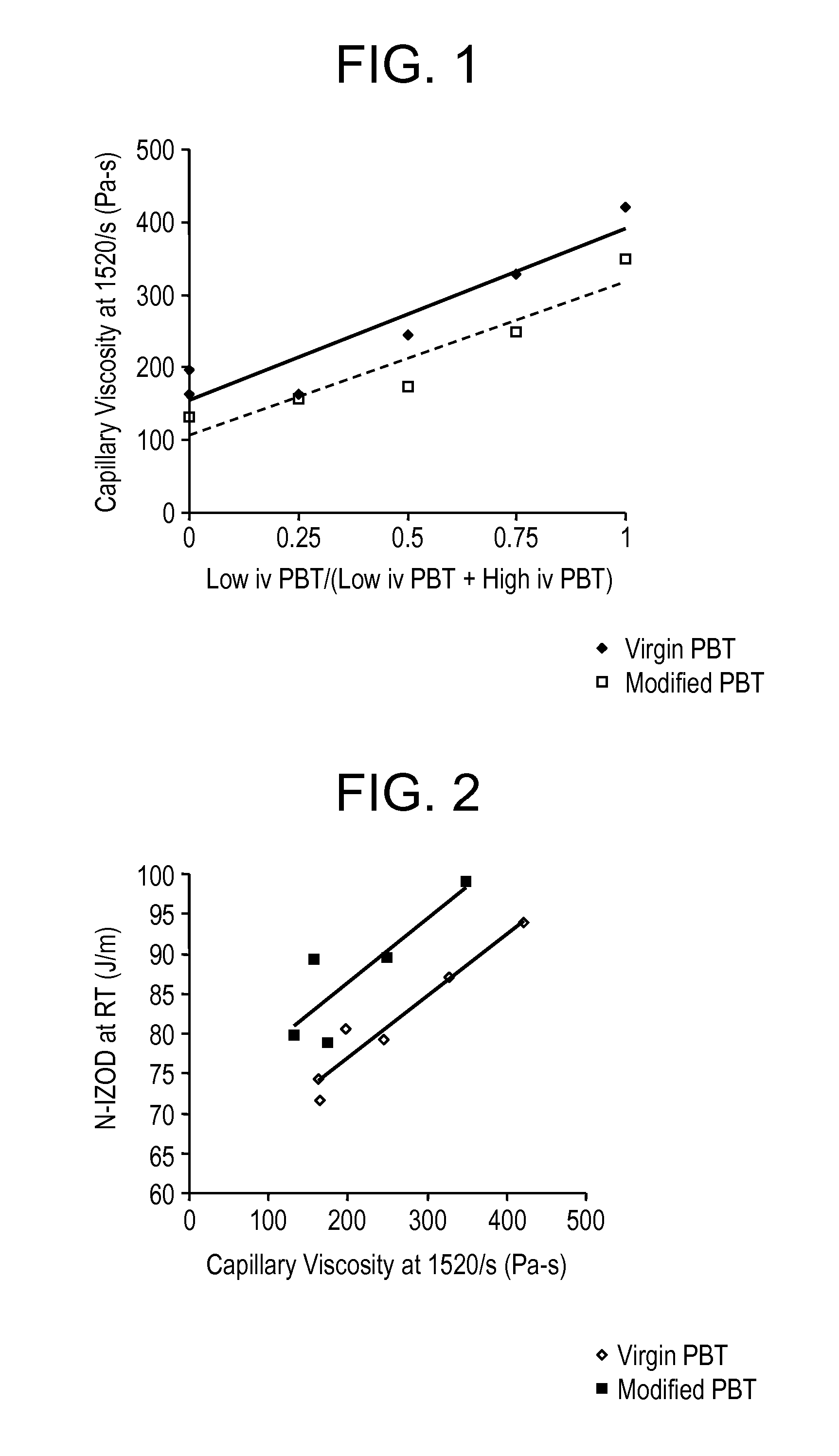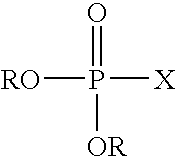Molding compositions containing fillers and modified polybutylene terephthalate (PBT) random copolymers derived from polyethylene terephthalate (PET)
a technology of polyethylene terephthalate and polybutylene terephthalate, which is applied in the direction of transportation and packaging, special tyres, coatings, etc., can solve the problems of not meeting the long-held need of improving use of documents, pbt-polycarbonate-impact modifier molding compositions generally cannot be made from recycled sources of pbt,
- Summary
- Abstract
- Description
- Claims
- Application Information
AI Technical Summary
Benefits of technology
Problems solved by technology
Method used
Image
Examples
example 1
[0207] A modified polybutylene terephthalate random copolymer was derived from polyethylene terephthalate as follows. Clear PET bottle scrap was obtained from a commercial source. In the scrap cleaning process, the PET scrap was cleaned manually involving first a hot water wash followed by manual sorting to separate colored bottles and PVC bottles, crushing, hydrofloatation to separate PP, labels, caps etc., alkali wash to remove glue, and finally a demineralized water wash to remove alkali followed by drying. The resulting PET flakes were used as the main raw material in the depolymerization step. The post consumer recycle PET flakes had an iv specification of 0.68 to 0.78 dl / g and a melting point specification of 245 to 255° C. The PVC content was less than 10 ppm by specification. The butanediol was obtained from BASF and had a purity specification of >99.5 wt. %. The ethylene glycol was obtained from Merck and had a purity specification of >99.5 wt. %. The TPT catalyst used was ...
examples 2-5
Glass Filled Compositions
[0214] Glass filled compositions with the indicated amounts of ingredients were as shown in Table 4 were made and tested.
TABLE 4Ex-Example 3am-(Com-Exam-Example 5ComponentUnitple 2parative)ple 4(Comparative)PET Derived PBT,wt. %16—35.52—(0.66 iv)PET Derived PBT,wt. %32.4—35.44—(1.2 iv)GE VIRGIN PBTwt. %—16—35.52195 (0.66 iv)GE VIRGIN PBTwt. %—32.4—35.44315 (1.2 iv)Standard 13wt. %30303030Micron Glass FiberPolycarbonate 105,wt. %22——100 GradePowderHigh Flowwt. %1818——Polycarbonate-Lexan ML8199-111NHydrocarbon Waxwt. %0.40.4——ReleaseMonosodiumwt. %0.20.2——Phosphate,AnhydrousHindered Phenolwt. %0.060.060.040.04Stabilizer (Irganox1010)Linear Lowwt. %11——DensityPolyethylene
[0215] The polycarbonate 105 (100 grade powder) and LEXAN ML8199-111N were both obtained from GE Plastics. The antioxidant was obtained from Ciba Geigy under the trade name IRGANOX® as IRGANOX® 1010. This antioxidant is a tetra functional 2, 6-di-tert butyl hindered phenol. The monosodium ph...
example 2
[0216] The ingredients of Example 2 shown above were extruded on a 89 mm Single Screw Extruder with a vacuum vented mixing screw, at a barrel and die head temperature between 240 and 265° C. and 150 to 300 rpm screw speed. The extruder has 8 independent feeders for different raws with a downstream feeder for glass and can be operated at a maximum rate of 600 lbs / hr (272.2 kg / hour). The extrudate was cooled through a water bath prior to pelletizing. Test parts were injection molded on a van Dorn molding machine with a set temperature of approximately 240 to 265° C. The pellets were dried for 3-4 hours at 120° C. in a forced air circulating oven prior to injection molding.
PUM
| Property | Measurement | Unit |
|---|---|---|
| wt. % | aaaaa | aaaaa |
| wt. % | aaaaa | aaaaa |
| wt. % | aaaaa | aaaaa |
Abstract
Description
Claims
Application Information
 Login to View More
Login to View More - R&D
- Intellectual Property
- Life Sciences
- Materials
- Tech Scout
- Unparalleled Data Quality
- Higher Quality Content
- 60% Fewer Hallucinations
Browse by: Latest US Patents, China's latest patents, Technical Efficacy Thesaurus, Application Domain, Technology Topic, Popular Technical Reports.
© 2025 PatSnap. All rights reserved.Legal|Privacy policy|Modern Slavery Act Transparency Statement|Sitemap|About US| Contact US: help@patsnap.com



